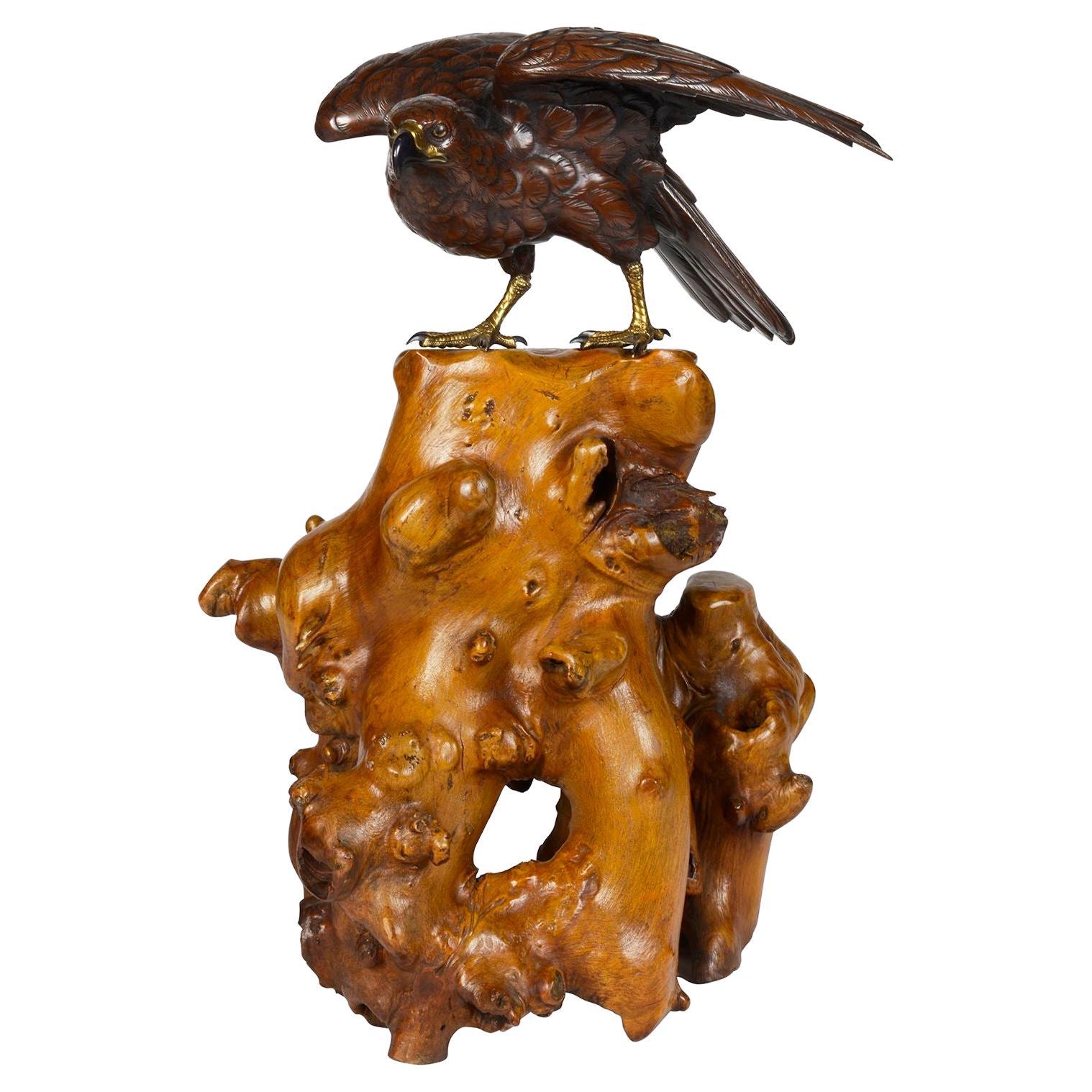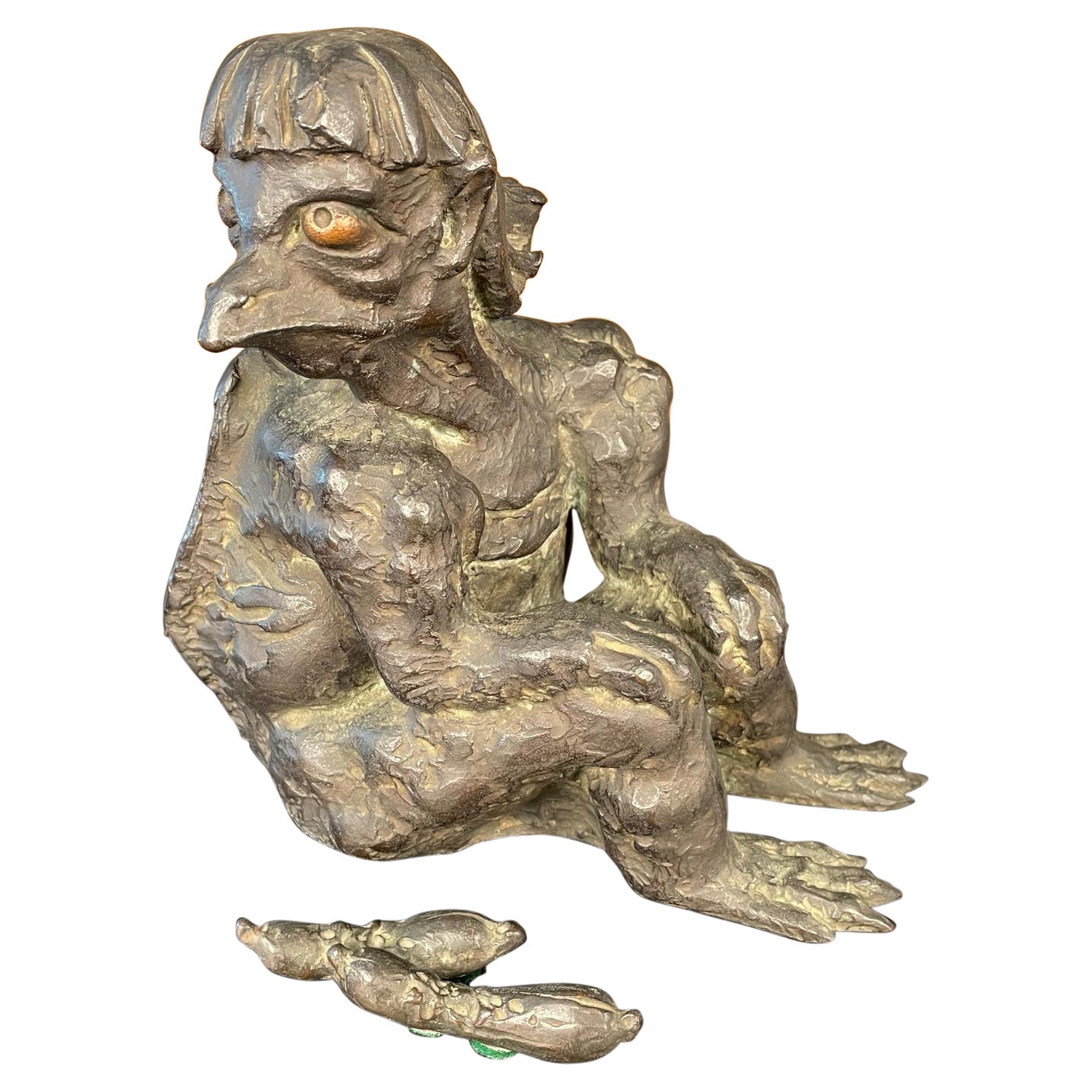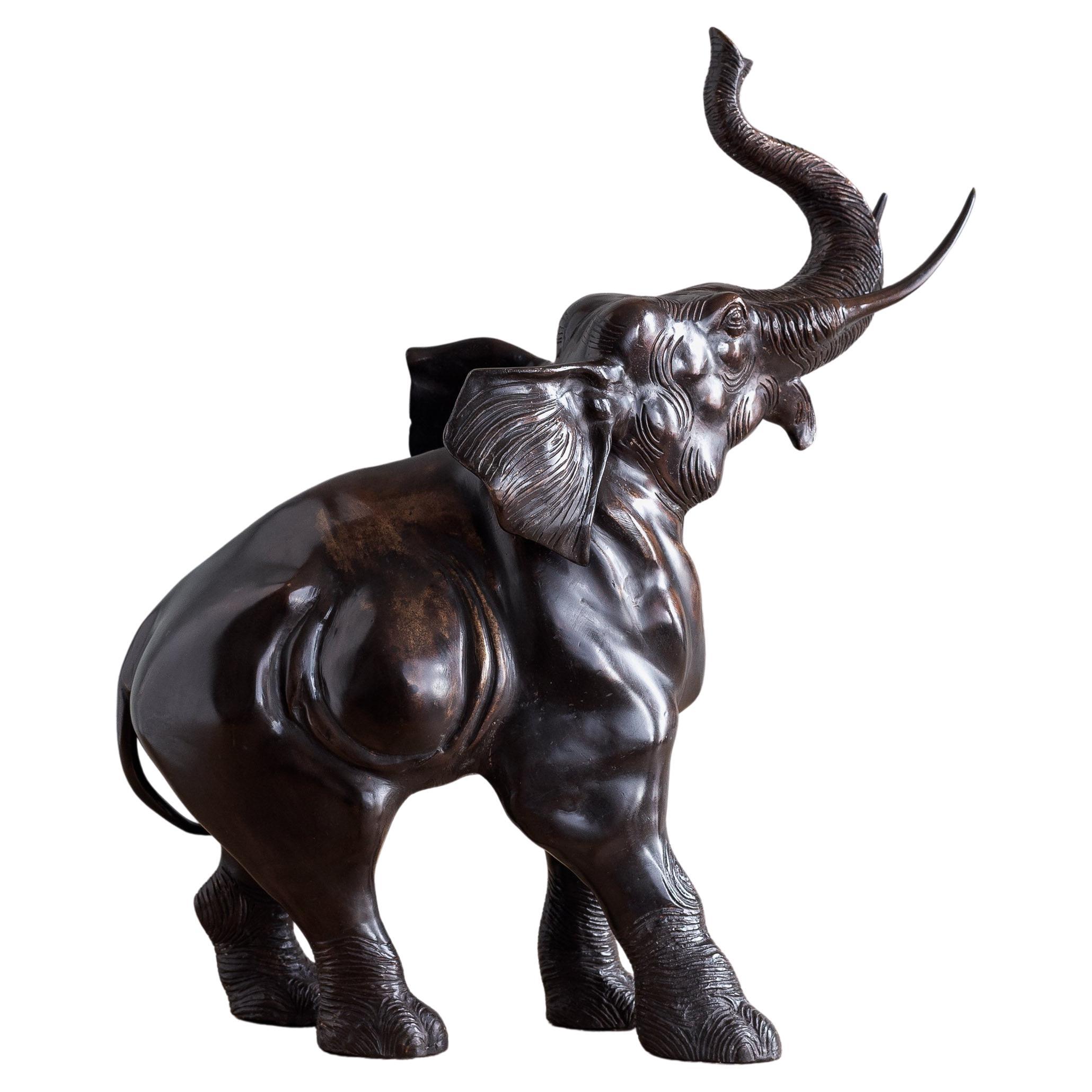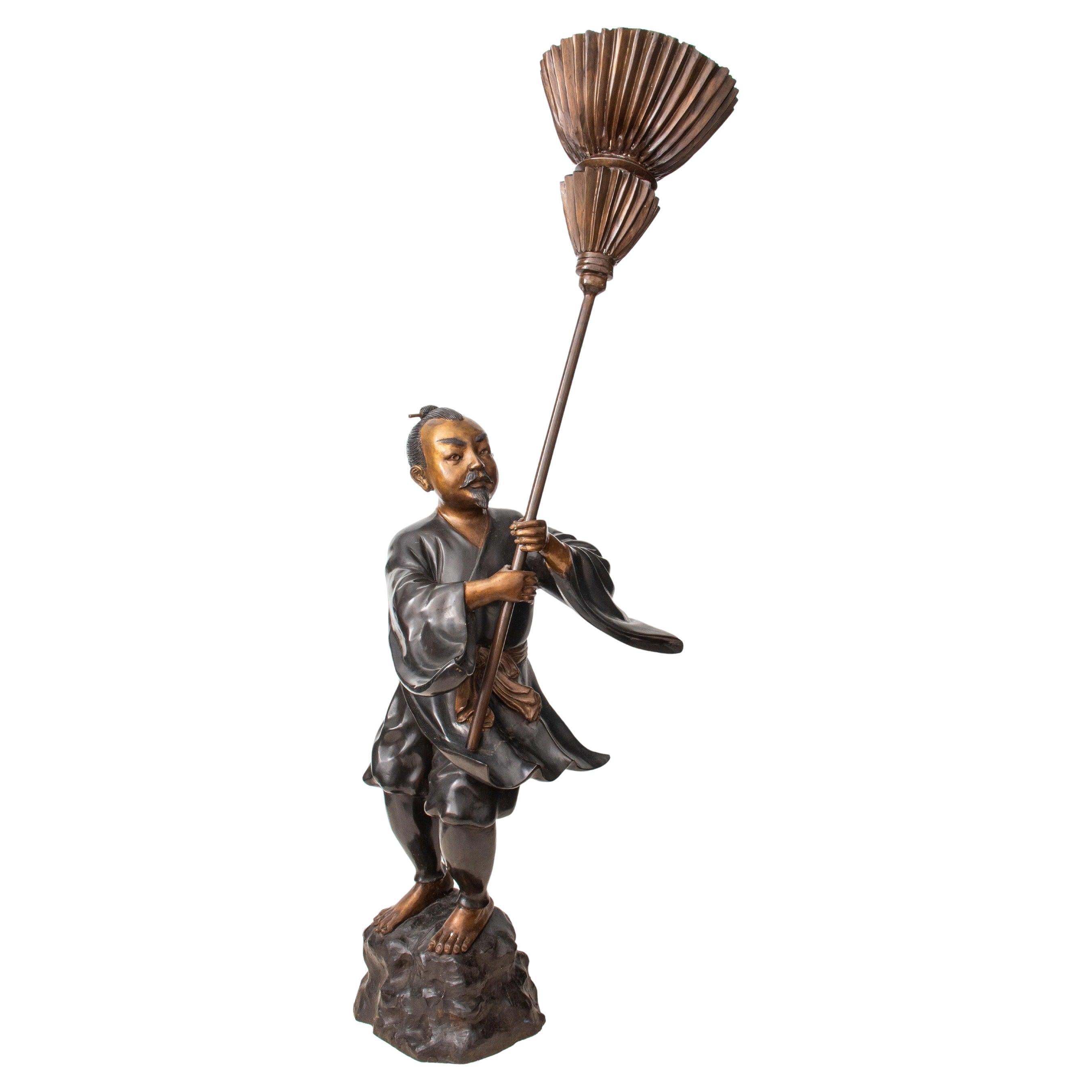Items Similar to Japanese Silvered Bronze Model of a Goshawk, circa 1890
Want more images or videos?
Request additional images or videos from the seller
1 of 7
Japanese Silvered Bronze Model of a Goshawk, circa 1890
About the Item
A SILVERED-BRONZE MODEL
OF A GOSHAWK
By Kunichika, Meiji era (1868-1912),
late 19th/early 20th century
Naturalistically rendered, standing alert with its head lowered, its wings drawn in, the beak of shakudo, the eyes of gilt with shakudo pupils, signed beneath the tail in a rectangular gilt reserve Kunichika; perched on a detachable tall tree trunk from which issues flowering hydrangea.
Overall height: 66.5cm x 45cm (26 1/8in x 173/4in). (2).
Batch 69.
- Creator:Toyohara Kunichika (Sculptor)
- Dimensions:Height: 25.99 in (66 cm)Width: 14.97 in (38 cm)Depth: 11.03 in (28 cm)
- Materials and Techniques:
- Place of Origin:
- Period:
- Date of Manufacture:1890
- Condition:Wear consistent with age and use.
- Seller Location:Brighton, GB
- Reference Number:
About the Seller
5.0
Platinum Seller
These expertly vetted sellers are 1stDibs' most experienced sellers and are rated highest by our customers.
1stDibs seller since 2015
436 sales on 1stDibs
Typical response time: 1 hour
Associations
LAPADA - The Association of Arts & Antiques Dealers
- ShippingRetrieving quote...Ships From: Brighton, United Kingdom
- Return PolicyA return for this item may be initiated within 14 days of delivery.
More From This SellerView All
- Japanese Meiji period bronze Hawk, circa 1890Located in Brighton, SussexA fine quality late 19th Century Meiji period Japanese patinated Bronze study of a Hawk, having gilded highlights such as the claw feet and face. Mounted on a carved hardwood root ba...Category
Antique Late 19th Century Japanese Sculptures and Carvings
MaterialsBronze
- Japanese Meiji Period, Miyao Bronze Statue of a MusicianBy Eisuke Miyao 1Located in Brighton, SussexA fine quality Meiji period (1868-1912) Miyao bronze statue of a female muscian, having wonderful gilded high lights and mounted on a hardwood stand. Sign...Category
Antique 19th Century Japanese Sculptures and Carvings
MaterialsBronze
- Large Japanese Miayo Bronze figure of Benkei holding a bell. 71cmBy Eisuke Miyao 1Located in Brighton, SussexA large and impressive fine quality Japanese Meiji period (1868-1912) Miyao Bronze figure depicting Benkiei holding a bell above his head, having a wonderful original patination with...Category
Antique 19th Century Japanese Sculptures and Carvings
MaterialsBronze
- Japanese Meiji period bronze Elephant fighting two Lions.Located in Brighton, SussexA fine quality Dramatic late 19th Century Japanese Meiji period (1868-1912) patinated bronze Elephant being attacked by two Lions, set on a carved wooden base, signed to the undersid...Category
Antique Late 19th Century Japanese Sculptures and Carvings
MaterialsBronze
- Large Japanese Meiji period Bronze Lion 34" (87cm) wideLocated in Brighton, SussexA very impressive 19th century Japanese Meiji period (1868-1912) bronze lion on a rock. Signed.Category
Antique 1880s Japanese Sculptures and Carvings
MaterialsBronze
- 19th Century Silvered bronze mother and children dancing. By CarrierBy Albert-Ernest Carrier-BelleuseLocated in Brighton, SussexAn enchanting classical French 19th Classical silvered bronze statue depicting a mother and her children dancing, mounted on a gilded base. Sign...Category
Antique Late 19th Century French Sculptures and Carvings
MaterialsBronze
You May Also Like
- Japanese Bronze Folk Art Kappa, circa 1930Located in South Burlington, VTJapan, a beautiful, unusual and possibly unique antique hand cast bronze "Kappa" (child protector) sculptor complete with a separately formed bronze pair of 3.5 inch long cucumbers- a kappa's favorite snack food. Signed. Signed An incised artist signature “Buraku” on base. "Bunraku" is associated with Japanese puppet play and performance, Kappa Bring Good Fortune Japanese Kappa...Category
Early 20th Century Japanese Showa Sculptures and Carvings
MaterialsBronze
- Japanese Bronze of an ElephantLocated in London, GBJapanese bronze of an elephant, mid-twentieth century, modelled with trunk aloft, a substantial, attractively modelled sculpture with pleasing colour and finish.Category
Mid-20th Century Japanese Sculptures and Carvings
MaterialsBronze
- Japanese Bronze Figure of Attendant w/ ChamaraLocated in New York, NYJapanese large bronze sculpture in two parts depicting an attendant standing atop a rocky base and holding a chamara fly-whisk or -swish used to sweep ignorance and fan deities, the ...Category
Early 20th Century Japonisme Sculptures and Carvings
MaterialsBronze
- Japanese Bronze of Miyao in Patinated and Gilded BronzeLocated in Saint-Ouen, FRJapanese bronze of Miyao in patinated and gilded bronze on wooden base, 19th century, Japan, Meji period. Measures: H 13 cm, W 7 cm, D 6 cm.Category
Antique 19th Century Japanese Meiji Sculptures and Carvings
MaterialsBronze
- Japan 1890 Meiji Period Signed Assembling of Okimono with a Group of SkeletonsLocated in Miami, FLA signed Okimono from the Japanese Meiji period (1868-1912). Very rare, unusual and large sculptural assembling of a dysplaying piece of okimono. Created in Japan during the imperial period of the Meiji (1868-1912). This extraordinary piece okimono sculpture depict a group of four intricately and realistically rendered carousing males skeletons representations (Gaikotsu) standing in several position. One skeleton is crouched down playing with mouses in the floor. The second is seated resting in the other's back, peacefully smoking opium. The others two are fully standing in interacting position. The entire composition is arranged freely displayed on the wood base including a woven basket, apparently with food and four playfull mouses. There are an extra five mouses in different positions, freely playing around, all of them with the eyes accented with carved black ebony. The composition is displayed on a four-legged free form carved wood platform with an inlaid red plaque engraved with the artist's signature. The level of detail and the quality of the carving is truly exceptional. Has an exact measurements of 216.15 mm by 139.7 mm by 359.41 mm (8.51 x 5.5 x 14.15 Inches). After an extensive collection of data, comparables and references to this piece, we have only been able to find only three okimono sculptures like this, with similar themes and the same quality of work. References Note: A similar carving of four skeletons playing an animated game of dominos, signed Shutaro in an inlaid rectangular red plaque, was sold in London by Christie’s South Kensington in October 14 2014, Lot 120 Sale 5546. References Note: A similar carving with four skeletons in an otherwise typical victorian scene of a photographer and three sitters signed Shutaro in an inlaid rectangular red plaque, was sold in Edinburgh at Lyon & Turnbull in November 7, 2018. References Note: A similar carving with five skeletons seated, playing cards and drinking, was sold in London by John Nicholson Fine Art on September 26, 2018. Meiji period, is an era of Japanese history that extended from October 23, 1868 to July 30, 1912.The Meiji era was the first half of the Empire of Japan, when the Japanese people moved from being an isolated feudal society at risk of colonization by Western powers to the new paradigm of a modern, industrialized nation state and emergent great power, influenced by Western scientific, technological, philosophical, political, legal, and aesthetic ideas. As a result of such wholesale adoption of radically different ideas, the changes to Japan were profound, and affected its social structure, internal politics, economy, military, and foreign relations. The period corresponded to the reign of Emperor Meiji. It was preceded by the Keio era and was succeeded by the Taisho era, upon the accession of Emperor Taisho. Okimono, is a Japanese term meaning for display an ornament; art object; or decorative object, usually displayed in a tokonoma or butsudan "Buddhist altar". It is an ornament or figure, especially one placed in a guest room. An okimono may be a small Japanese carving...Category
Antique 1890s Japanese Meiji Sculptures and Carvings
MaterialsWood
- Japan 1890 Meiji Period Signed Okimono Sculpture of a Group of Skeletons SmokingLocated in Miami, FLSculptural signed Okimono from the Japanese Meiji period (1868-1912). Very rare, unusual and large sculptural assembling of a dysplaying piece of okimono. Created in Japan during the imperial period of the Meiji (1868-1912). This extraordinary okimono was carefully carved depicting a group of three intricately and realistically rendered carousing skeletons (Gaikotsu) in relax and resting position, drinking and smoking. Two of them, probably males representations are resting on a wicker sofa. The third, is a woman seated in a lower stool offering drinking cups of sake on a round tray. A small rectangular bench is arranged in the scene. The composition is displayed on a four-legged carved wood platform with an inlaid red plaque engraved with the artist's signature. The level of detail and the quality of the carving is truly exceptional. Has an exact measurements of 209.55 mm by 196.85 mm by 127.76 mm (8.25 x 7.75 x 5.03 Inches). After an extensive collection of data, comparables and references to this piece, we have only been able to find only three okimono sculptures like this with similar themes and the same quality of work. References Note: A similar carving of four skeletons playing an animated game of dominos, signed Shutaro in an inlaid rectangular red plaque, was sold in London by Christie’s South Kensington in October 14 2014, Lot 120 Sale 5546. References Note: A similar carving with four skeletons in an otherwise typical victorian scene of a photographer and three sitters signed Shutaro in an inlaid rectangular red plaque, was sold in Edinburgh at Lyon & Turnbull in November 7, 2018. References Note: A similar carving with five skeletons seated, playing cards and drinking, was sold in London by John Nicholson Fine Art on September 26, 2018. Meiji period, is an era of Japanese history that extended from October 23, 1868 to July 30, 1912. The Meiji era was the first half of the Empire of Japan, when the Japanese people moved from being an isolated feudal society at risk of colonization by Western powers to the new paradigm of a modern, industrialized nation state and emergent great power, influenced by Western scientific, technological, philosophical, political, legal, and aesthetic ideas. As a result of such wholesale adoption of radically different ideas, the changes to Japan were profound, and affected its social structure, internal politics, economy, military, and foreign relations. The period corresponded to the reign of Emperor Meiji. It was preceded by the Keio era and was succeeded by the Taisho era, upon the accession of Emperor Taisho. Okimono, is a Japanese term meaning for display an ornament; art object; or decorative object, usually displayed in a tokonoma or butsudan "Buddhist altar". It is an ornament or figure, especially one placed in a guest room. An okimono may be a small Japanese...Category
Antique 1890s Japanese Meiji Sculptures and Carvings
MaterialsWood
Recently Viewed
View AllMore Ways To Browse
A Detacher
Bronze Model
Antique Japanese Silver
Japanese Antique Silver
Bronze Era
1890 Japan
Rectangular Carving
Tree Carvings
Cast Bronze Leaf
Japanese Silver Leaf
Antique Japanese Bronze Sculpture
Japanese Silver Sculpture
Head Bronze Asian
Trunk Asia
Japanese Gilt Bronze
Japanese Meiji Carving
Japanese Silvered Bronze
Bronze Trunk





